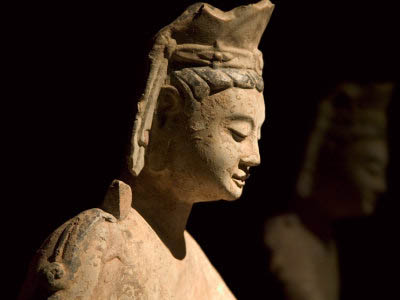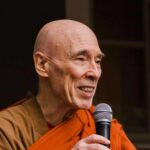Bodhisattva (Pali and Sanskrit, from bodhi “awakened” + sattva “being”): any person who, motivated by compassion, wishes to attain Buddhahood for the sake of all living beings.
 Unless you’reon long retreat in a Himalayan cave, it’s becoming more difficult to overlook the fact that our world is beset by interacting ecological, economic and social crises. Climate breakdown … massive species extinction … a dysfunctional economic system … corporate domination of government … overpopulation … The list is long.It’s a critical time in human history, and thecollective decisions to be made during the next few years may set the course of events for generations to come.
Unless you’reon long retreat in a Himalayan cave, it’s becoming more difficult to overlook the fact that our world is beset by interacting ecological, economic and social crises. Climate breakdown … massive species extinction … a dysfunctional economic system … corporate domination of government … overpopulation … The list is long.It’s a critical time in human history, and thecollective decisions to be made during the next few years may set the course of events for generations to come.
Yet the more we learn about our situation, the more overwhelmed and discouraged many of us become. The problems are so enormous and intimidating … where to start? We end up feeling powerless, even paralyzed.
For those inspired by Buddhist teachings, an important issue is whether Buddhism can help us respond to these crises. Of course, we can’t expect to find precise answers to contemporary difficulties in ancient Buddhist texts. The Buddha lived in Iron Age India, and his society faced a different set of problems – such as aggressive monarchies competing to swallow up other states. Buddhism today cannot help us decide whether to rein ingrowth-obsessed capitalism or to replace it with a more socially responsible economic system. We can’t depend on the Buddha to tell us whether a revitalized representative democracy can work well enough or whether we should push for more decentralized, localized governance.
Nor does Buddhism imply a new political party or social movement. As Paul Hawken points out in Blessed Unrest, there are already a vast number of large and small organizations working for peace, social justice, and sustainability – at least a million and perhaps over two million, he estimates. The question is whether a Buddhist perspective has something distinctive to offer, which cancontribute something otherwise lacking in this movement. What might that be?
Historically, churches and churchgoers have played an important part in some reform movements – for example, anti-slavery and civil rights campaigns. But much, perhaps most of the impetus in the West for deep structural change originates from Marxism and other socialist movements, which traditionally have been suspicious of religion. Marx viewed religion as “the opiate of the people” because too often churches have been complicit with political oppression, using their doctrines to rationalize the power of exploitative rulers and diverting believers’ attention from their present condition to “the life to come.” This critique applies to some Buddhist institutions as well – karma and rebirth teachings can be abused in this way – but at its best Buddhism offersan alternative approach: the spiritual path is about personal transformation, not to qualify for heaven but to live in a different wayhere and now. This Buddhist focus supplements nicely the customary Western focus on social justice and social transformation. As Gary Snyder put it half a century ago, “The mercy of the West has been social revolution. The mercy of the East has been individual insight into the basic self/void. We need both.”
We need both because, without also acknowledging the importance of individual transformation, social transformation isrepeatedly subverted by powerful elites taking selfish advantage of their position. Democracy may be the best form of government, but it guarantees nothing, especially if people are still motivated by greed, ill-will, and the delusion of a self whose well-being can be pursued indifferent to others’ well-being.
We also need both to respond fully to the Buddha’sconcern to enddukkha(suffering). The Buddha emphasized that all he had to teach was dukkha and how to end it. This implies that social transformation is also necessary, in order to address the structural and institutionalized dukkha perpetuated by those who benefit from an inequitable social order.
Is there something specific within the Buddhist tradition that can bring these two types of transformation together, in a new model of activism connecting inner and outer practice?
Enter … the Bodhisattva.
In the Pali Canon, the bodhisattva refers to the earlier lives of Shakyamuni before he becamethe Buddha. According to a common sectarian account, there was a conspicuous difference between his accomplishment and that of the arahants who fully awakened by following his teaching. By definition, an arahant has attained the same nibbana as the Buddha, but the Buddha was nonetheless special because he devoted himself to helping everyone awaken. This led to the development of a more altruistic model of how to live, whichsupposedly demonstrates the superiority of the Mahayana (literally, “Greater Vehicle”) tradition over the Theravada, the so-called Hinayana “Lesser Vehicle.”
It has been difficult for scholars to determine how much historical truth there is in this story, but in any case it’s essential to distinguish the bodhisattva conception from such doctrinal claims. Today, more than ever, we need to understand the bodhisattva path as a spiritual archetype that offers a new vision of human possibility – an alternative to rampant self-preoccupied individualism.
According to the usual myth, the bodhisattva is self-sacrificing because he or she could disappear into parinibbana, but instead takes a vow to hang around samsara in order to help the rest of us.The problem with this account is that such altruism still distinguishes the best interests of the bodhisattva from the best interests of everyone else. There is a more nondual way to understand what motivates the bodhisattva, if we understand enlightenment as the realization that I am
not separate from others. Although not a Buddhist, the neo-Advaitin Nisargadatta made this point very well: “When I look inside and see that I am nothing, that’s wisdom. When I look outside and see that I am everything, that’s love. Between these two my life turns.” Wisdom and compassion: the two wings of the Buddhist path, and we need both to fly. Wisdom is realizing that there is no “me” separate from the rest of the world, and compassion is putting that realization into practice.
In that case, however, the bodhisattva’s preoccupation with helping “others” is not a personal sacrifice but a further stage of personal development. Awakening to my nonduality with the world does not automatically eliminate habitual self-centered ways of thinking and acting. Following the bodhisattva path is important for re-orienting one’s relationship with the world. Instead of asking “what can I get out of this situation?” one asks: “what can I contribute to this situation, to make it better?”
The bodhisattva path can be understood as a myth that makes an important distinction between two basic ways of understanding the Buddhist path: do I follow the path to end my own suffering, or to help end the suffering of everyone?
If we take the story in that way, does it give us some special perspective on our predicamenttoday?The answer, I believe, is quite clearly yes: it speaks directly to an important tension between “self-help” Buddhism and socially engaged Buddhism.
American convert Buddhists are predominantly white and middle-class. Many are professionals with demanding jobs, and practices such as metta and mindfulness meditation provide much-needed relief from the pressures of daily life. Such practitionersseek quiet time in a peaceful place to de-stress and pursue their own enlightenment.
Without denigrating in any way the importance of such practice, we also need to ask: does this approach help to develop an awakened society that is socially just and ecologically sustainable, or does it instead tend to maintain the present social order?Is Western Buddhism being commodified and co-opted into a self-help stress-reduction program that does not challenge institutionalized dukkha but adapts to it, leavingpractitioners atomized and isolated? Or ismodern Buddhism opening up new perspectives and possibilities that challenge us to transform ourselves and our societies more profoundly?
A recent critique of contemporary Buddhism by the influential philosopher and cultural critic Slavoj Zizek addresses this issue squarely. In his view, Western Buddhism is becoming “the hegemonic ideology of global capitalism” because its“meditative stance is arguably the most efficient way for us to fully participate in capitalist dynamics while retaining the appearance of mental sanity.” Western Buddhism “enables you to fully participate in the frantic pace of the capitalist game while sustaining the perception that you are not really in it; that you are well aware of how worthless this spectacle is; and that what really matters to you is the peace of the inner Self to which you know you can always withdraw.”
Zizek may not know much about Buddhist teachings, but he is a perceptive observer of contemporary culture, and one of the roles that Buddhism is serving within that culture. An alternative role is a more engaged Buddhism, which brings us back to the bodhisattva path as a new archetype for social activism.
Bodhisattva activism has some distinctive characteristics. Buddhist emphasis on interdependence (“we’re all in this together”) and delusion(rather than evil) implies not only nonviolence (which is usually self-defeating anyway) but a politics based on love (more nondual) rather than anger (which dualizes between us and them). The basic problem is not rich and powerful bad people but institutionalized structures of collective greed, aggression, and delusion. The Buddha’s pragmatism and non-dogmatism –for example, his teachings as a raft not to be carried on our backs – can help to cut through the ideological quarrels that have weakened so many progressive groups. And Buddhist emphasis on upaya-kausalya “skillful means” foregrounds the creative imagination, a necessary attribute if we are to construct a healthier way of living together on this earth, and work out a way to get there.
Yet those attributes do not get at the most important contribution of the bodhisattva in these difficult times, when we often feel overwhelmed by the magnitude of the challenge and are tempted to despair. The bodhisattva’s response? To quote the U.S. Army Corps of Engineers: “The difficult we do immediately. The impossible will take a little longer.” According to the classical formulation, the bodhisattva takes a vow to help liberate all living beings. Someone who has volunteered for such an unachievabletask is not going to be intimidated by present crises, no matter how hopelessthey may appear. That is because the bodhisattva practices on both levels, inner and outer, which enables one to engage in goal-directed behavior without attachment to results.
As T. S. Eliot put it, “Ours is in the trying. The rest is not our business.” The bodhisattva’s job is to do the best one can, without knowing what the consequences will be. Have we already passed ecological tipping-points and human civilization is doomed? We don’t know –yetrather than being intimidated the bodhisattva embraces “don’t know mind,” because Buddhist practice opens us up to the awesome mystery of an impermanent world where everything is changing whether or not we notice. I grew up in a world defined by a“cold war” between the USA and the Soviet Union, which we all took for granted – until communism suddenly collapsed overnight. The same thing occurred with South African apartheid. If we don’t really know what’s happening, do we really know what’s possible, until we try?
The equanimity of the bodhisattva-activist is due to nonattachment to the fruits of one’s action, which is not detachment from the state of the world or the fate of the earth. What is the source of that nonattachment? That points to the fruits of the bodhisattva’s inner work. The Diamond Sutra says that we save all living beings by realizing that there are no living beings to save. The bo
dhisattva realizes shunyata – poorly translated as “emptiness” – that dimension in which there is nothing to gain or lose, no getting better or worse. The danger, for practitioners, is becoming attached to that realization (“clinging to emptiness”), which is as one-sided as being attached to particular forms. As the Heart Sutra emphasizes, forms are empty, and emptiness is form.Emptiness is not a place to dwell that isfree from form; it is experienced only in/as the impermanent forms it takes, the forms that constitute our lives and our world.
For the Buddhist activist these are the two dimensions of practice, opposite sides of one coin. As Nisargadatta might put it, “Between these two the bodhisattva’s life turns.” Our world needs both.
[June 2012]
David R. Loy











